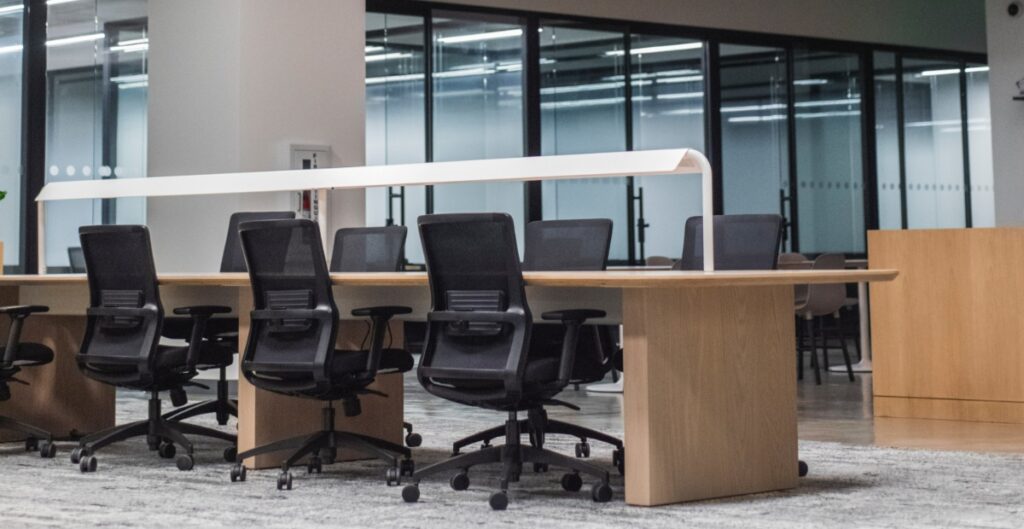In recent years, the topic of energy efficiency has gained more attention as individuals and businesses seek to reduce their carbon footprint and lower their energy bills. The UK, in particular, has set ambitious targets to achieve net-zero emissions by 2050, which has made it imperative for all sectors to play their part in reducing energy consumption. Energy saving has never been easier, with ways to save and reduce the amount of consumption available throughout the office.
As the world becomes more aware of the need to reduce greenhouse gas emissions, businesses are starting to recognize the importance of being energy-efficient. Offices are notorious for consuming a lot of energy, which not only adds up to high bills but also contributes to environmental degradation. However, there are simple steps that can be taken to reduce energy consumption in the office and make it more eco-friendly.
This article aims to provide tips and insights on how to make your office more energy-efficient. It will cover various areas such as lighting, heating, cooling, and appliances, providing practical solutions that are easy to implement. The article will also explore the benefits of being energy-efficient and how it can help businesses save money while protecting the environment.
Whether you are a small business owner or an employee looking to make a difference, this article will offer valuable insights into energy efficiency in the office. By implementing some of these tips, you can contribute to a more sustainable future while also enjoying cost savings. So, without further ado, let’s dive into the world of energy efficiency and learn how to make our offices more eco-friendly.
What is the difference between commercial and domestic energy use?
Commercial and domestic energy use differ significantly in terms of scale and purpose. Domestic energy consumption is the energy used by households for heating, cooling, lighting, cooking, and other daily activities. On the other hand, commercial energy consumption refers to the energy used by businesses and organizations for various purposes such as manufacturing, production, heating and cooling of large buildings, and powering equipment and machinery.
Commercial energy consumption is generally much higher than domestic energy consumption due to the size and complexity of commercial operations. Large commercial buildings require significant amounts of energy for heating, cooling, and lighting, and many commercial activities involve the use of heavy machinery and equipment that require a lot of energy to operate.
The energy sources used in commercial and domestic settings also differ. Domestic energy consumption is typically met through electricity, gas, and oil, while commercial energy consumption may also involve the use of other energy sources such as coal, biomass, and renewable energy sources like solar and wind power.
Another significant difference between commercial and domestic energy consumption is the way that energy use is monitored and managed. Businesses and organizations have access to more advanced energy management systems than individuals, which allows them to monitor their energy usage in real-time, identify areas of high consumption, and implement measures to reduce energy waste and increase efficiency.
In summary, while both commercial and domestic energy consumption involves the use of energy for heating, cooling, lighting, and other activities, commercial energy consumption is generally much higher due to the scale and complexity of commercial operations. Commercial energy consumption also involves a wider range of energy sources and more advanced energy management systems than domestic energy consumption.
How do offices use energy?
Offices are one of the largest consumers of energy, accounting for a significant portion of energy usage in the UK. The amount of energy used by offices depends on the size of the office and the number of employees, as well as the type of equipment and appliances used. Some may rely on air conditioning and see a lot of their office energy being spent on the air conditioner’s electricity bill. Small business energy is slightly different too, with tips to save electricity keeping your office space happy and productive.
The primary energy consumption in offices comes from lighting, heating, and cooling. Lighting accounts for around 20% of energy usage in an office, while heating and cooling account for up to 40%. Other equipment, such as computers, printers, and other electronics, can also contribute significantly to energy usage. Energy saving ideas and ways to save energy can really focus on these areas during office hours to help save and improve energy consumption.
One way offices can reduce their energy usage is by implementing energy-efficient technologies and practices. This can include upgrading to LED lighting, installing programmable thermostats, and using energy-efficient appliances and equipment. It can also involve encouraging employees to adopt energy-saving habits, such as turning off lights and electronics when not in use, and setting computers to sleep mode.
Another way to reduce energy usage in offices is by implementing sustainable design principles. This can include maximizing natural lighting and ventilation, using low-emissivity windows, and incorporating renewable energy sources such as solar panels.
In addition to reducing energy usage, implementing these practices can also save businesses money on their energy bills, which can have a positive impact on their bottom line. By adopting sustainable practices and investing in energy-efficient technologies, businesses can also demonstrate their commitment to sustainability and contribute to a cleaner, more sustainable future.
How Can I Save on Energy Costs in the Office?
Saving on energy costs in the office is not only beneficial for the environment, but it can also significantly reduce your business’s expenses. Switching to energy efficient office is important in pursuing the kind of business you want to be. Here are some tips on how to save on energy costs in the office, especially during normal work hours.
-
Switch to LED lighting: LED bulbs use significantly less energy than traditional incandescent bulbs, and they also last longer.
-
Turn off equipment when not in use: Computers, monitors, printers, and other equipment should be turned off when not in use, as they continue to consume energy even when in standby mode.
-
Invest in energy-efficient equipment: When purchasing new office equipment, opt for those with an Energy Star rating, as they use less energy and are more efficient.
-
Use natural light: Maximise natural light by opening blinds and curtains and using skylights if possible. This reduces the need for artificial lighting.
-
Set office temperature appropriately: Setting the office temperature to an appropriate level can significantly reduce energy consumption. In the summer, set the temperature to around 24°C, while in winter, set it to around 20°C.
-
Encourage energy-saving habits: Encourage employees to save energy by turning off lights and equipment when not in use, reporting any leaks, and using stairs instead of elevators.
-
Conduct an energy audit: Hire a professional to conduct an energy audit of your office. This will identify areas where energy use can be reduced and provide a plan for how to implement these changes.
By implementing these tips, you can significantly reduce your office’s energy consumption, lower your energy bills, and contribute to a more sustainable future.
Know your business energy use and waste
To save energy, it’s important to know how much energy your business is using and where waste is occurring. By understanding your energy use and waste, you can identify opportunities to reduce consumption, lower your energy bills, and improve your business’s environmental performance.
One way to do this is to conduct an energy audit, which involves analyzing your business’s energy consumption patterns, identifying inefficiencies, and recommending strategies to reduce energy use. An energy audit can help you identify areas of waste, such as equipment or lighting that is left on when not in use, and suggest ways to optimize your energy consumption, such as by upgrading to more efficient equipment or implementing better energy management practices.
You can also track your energy usage using smart meters, which provide real-time data on your energy consumption. By monitoring your energy use and identifying patterns, you can better manage your energy consumption and reduce waste. Additionally, many energy suppliers offer energy management tools and resources to help you track and analyze your energy usage.
Another way to reduce energy waste is to encourage employees to be more mindful of their energy use. Simple actions like turning off lights and equipment when not in use, using natural light instead of artificial lighting, and adjusting thermostats to maintain comfortable but energy-efficient temperatures can add up to significant energy savings over time.
Finally, consider investing in renewable energy solutions, such as solar panels or wind turbines, to generate your own clean energy and reduce your reliance on fossil fuels. Not only can this help reduce your energy costs over the long term, but it can also demonstrate your business’s commitment to sustainability and reducing its carbon footprint.
Overall, understanding your business’s energy use and waste is key to reducing energy costs and improving your environmental performance. Whether through energy audits, smart meters, employee engagement, or renewable energy solutions, there are many ways to optimize your energy consumption and save money while also supporting a greener future.
Switch off artificial lights and use natural light
Switching off artificial lights and making use of natural light is an effective way to reduce energy consumption in any business. In addition to reducing energy costs, using natural light can also improve the well-being and productivity of employees. Many businesses are now embracing the use of natural light as a key part of their energy-saving initiatives.
To make the most of natural light, businesses should consider the orientation of their buildings and the placement of windows. Buildings should be designed to maximize natural light and allow it to reach the interior spaces. Windows should be strategically placed to allow the maximum amount of light in while reducing glare and excess heat. Businesses should also consider installing shading devices such as blinds or awnings to regulate the amount of light that enters the building.
In addition to maximizing natural light, businesses should encourage employees to switch off artificial lights when they are not needed. This can be achieved through simple measures such as putting up reminders to switch off lights when leaving a room or installing motion sensors that automatically switch off lights when no one is in the room.
Making use of natural light can have a positive impact on both the environment and the bottom line of a business. By reducing energy consumption and costs, businesses can improve their sustainability and profitability. Furthermore, the use of natural light can improve the comfort and productivity of employees, creating a more pleasant and efficient work environment.
In summary, switching off artificial lights and making use of natural light is an effective way to reduce energy consumption in businesses. This can be achieved through strategic building design, window placement, and shading devices. Encouraging employees to switch off lights when not needed can also make a significant impact. By adopting these measures, businesses can save money, improve their sustainability, and create a more productive and comfortable work environment.
Buy energy efficient devices
In today’s world, we heavily rely on electronic devices to run our daily lives, both in our homes and businesses. These devices, from laptops to refrigerators, use a considerable amount of energy and contribute significantly to our energy bills. By investing in energy-efficient devices, we can significantly reduce our energy consumption and costs, as well as our carbon footprint.
The energy efficiency of devices is measured by their Energy Efficiency Rating (EER) or Energy Efficiency Ratio (EER). This rating is displayed on the device and ranges from A+++ to G, with A+++ being the most efficient and G being the least efficient. The higher the rating, the less energy the device consumes.
When shopping for energy-efficient devices, it’s essential to look for the Energy Star label. This label is a government-backed certification that identifies products that meet strict energy efficiency guidelines. Energy Star certified devices are up to 50% more efficient than standard models, which can save a significant amount of money on energy bills over time.
Investing in energy-efficient devices not only saves money on energy bills, but it can also increase the value of a property. Energy-efficient buildings are more attractive to buyers and tenants, as they are seen as environmentally friendly and cost-effective. In addition, investing in energy-efficient devices is an excellent way for businesses to demonstrate their commitment to sustainability and reducing their carbon footprint.
In conclusion, buying energy-efficient devices is a simple yet effective way to reduce energy consumption and costs, as well as contribute to a more sustainable future. By looking for the Energy Star label and investing in devices with a high energy efficiency rating, businesses can save money on their energy bills while reducing their impact on the environment.




